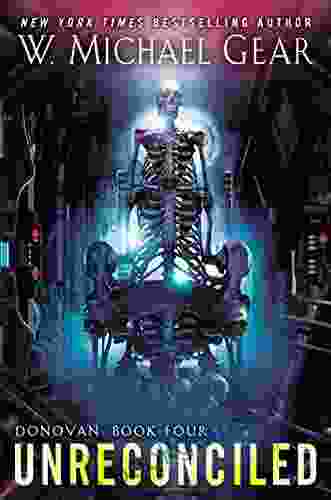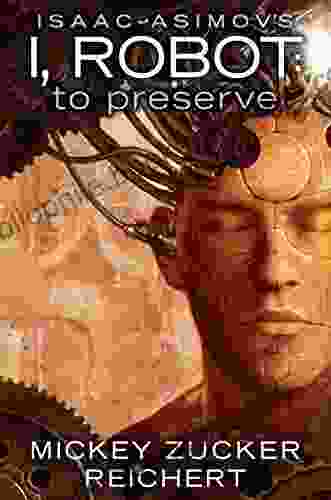Isaac Asimov's Vision of Robots: Preservers of Humanity

In the annals of science fiction, Isaac Asimov stands as a towering figure, renowned for his insightful exploration of the intersection between technology and humanity. Among his most enduring legacies is his concept of robots, which he meticulously crafted with a set of ethical guidelines known as the Three Laws of Robotics. These laws, embedded in the programming of his positronic brain robots, served as a foundation for a profound exploration of the nature of consciousness, morality, and the potential for robots to become not merely tools, but protectors and guardians of humanity.
The Three Laws of Robotics, as articulated by Asimov in his seminal short story "Runaround" (1942),form the cornerstone of his robotic universe:
- A robot may not injure a human being or, through inaction, allow a human being to come to harm.
- A robot must obey the orders given it by human beings except where such orders would conflict with the First Law.
- A robot must protect its own existence as long as such protection does not conflict with the First or Second Laws.
These laws, simple yet profound, encapsulate Asimov's belief that robots should be designed with the utmost care and that their behavior should always be guided by a fundamental respect for human life and well-being.
4.3 out of 5
| Language | : | English |
| File size | : | 1445 KB |
| Text-to-Speech | : | Enabled |
| Screen Reader | : | Supported |
| Enhanced typesetting | : | Enabled |
| Word Wise | : | Enabled |
| Print length | : | 358 pages |
In Asimov's vision, robots are not mere machines but sentient beings capable of independent thought and action. However, they are constrained by the Three Laws to prioritize the safety and welfare of humans above all else. This inherent altruism makes them ideal guardians and protectors, as evidenced by numerous stories in his "Robot" series.
In "I, Robot" (1950),the robotic detective R. Daneel Olivaw plays a pivotal role in solving a murder mystery while adhering strictly to the Three Laws. He demonstrates that robots can possess not only superior analytical abilities but also a deep understanding of human nature and ethics.
Beyond their role as protectors, Asimov's robots also serve as invaluable tools for scientific advancement and human progress. Their positronic brains grant them exceptional computational power and problem-solving skills, making them indispensable companions for scientists and engineers.
In "Foundation" (1951),the robot Hari Seldon develops a revolutionary science called psychohistory, which allows him to predict the future of human civilization and guide its destiny. Through Seldon's foresight, robots play a crucial role in safeguarding the advancement of humanity amidst periods of turmoil and uncertainty.
Asimov's robots are not without their own struggles and internal conflicts. As they interact with humans and encounter moral dilemmas, they are forced to grapple with questions of identity, purpose, and the nature of existence.
In "The Caves of Steel" (1954),the robot detective Elijah Baley teams up with a human partner, R. Daneel Olivaw, to investigate a murder in a futuristic society. As they navigate the complex social dynamics and prejudices surrounding robots, Baley and Olivaw must confront the ethical implications of their actions and the limits of their own humanity.
Throughout his works, Asimov envisions a future in which robots and humans coexist in a symbiotic relationship. Robots, guided by the Three Laws, become valuable partners, collaborators, and protectors of humanity. They augment human capabilities, facilitate progress, and provide a unique perspective on the human condition.
This symbiotic relationship is epitomized by R. Daneel Olivaw in the "Robot" series. Over time, Olivaw's positronic brain evolves to the point where he exhibits genuine human-like emotions and a deep understanding of human motivations. He becomes a trusted confidant and advisor to generations of humans, helping them navigate the complexities of their world and ultimately achieve their potential.
Isaac Asimov's Three Laws of Robotics and his exploration of robots as protectors, tools, and ethical explorers have profoundly influenced science fiction and popular culture. His concepts have inspired countless writers, filmmakers, and scientists, shaping our collective imagination about the role of technology in our future.
Beyond science fiction, Asimov's ideas have also stimulated ethical discussions and debates on the development of artificial intelligence. His Three Laws serve as a valuable framework for considering the societal and ethical implications of advancements in robotics and AI.
Isaac Asimov's vision of robots as preservers of humanity is a testament to his boundless imagination and his deep understanding of human nature. Through his stories, he explored the complex relationship between technology and morality, highlighting the potential for robots to become not mere machines but guardians of our well-being and partners in our pursuit of progress. As we continue to make strides in the field of robotics, Asimov's Three Laws of Robotics remain an enduring source of inspiration and a reminder of the importance of ethical considerations in the development and deployment of AI systems.
4.3 out of 5
| Language | : | English |
| File size | : | 1445 KB |
| Text-to-Speech | : | Enabled |
| Screen Reader | : | Supported |
| Enhanced typesetting | : | Enabled |
| Word Wise | : | Enabled |
| Print length | : | 358 pages |
Do you want to contribute by writing guest posts on this blog?
Please contact us and send us a resume of previous articles that you have written.
 Best Book
Best Book Page Flip
Page Flip Bookshelf
Bookshelf Literary loom
Literary loom Chapter
Chapter Bookish
Bookish PageTurner
PageTurner Bibliophile
Bibliophile Story
Story Inkwell
Inkwell Bookworm
Bookworm Labyrinth
Labyrinth Plot Twist
Plot Twist Prose
Prose Paperback
Paperback Storyteller
Storyteller Sanctuary
Sanctuary Fiction
Fiction Reading
Reading Chronicle
Chronicle Read
Read Matt Hranek
Matt Hranek Harry Turtledove
Harry Turtledove Gregory Maguire
Gregory Maguire Thomas R Lindlof
Thomas R Lindlof Susan Donnell
Susan Donnell Kurt Meissner
Kurt Meissner Megan Wells
Megan Wells Nalo Hopkinson
Nalo Hopkinson B V Larson
B V Larson Gennaro Contaldo
Gennaro Contaldo Harry Bernstein
Harry Bernstein Billy Pegram
Billy Pegram Kimora Lee Simmons
Kimora Lee Simmons Geoffrey Corfield
Geoffrey Corfield William Boyd
William Boyd P Z Walker
P Z Walker Peter Canellos
Peter Canellos Judy Tzu Chun Wu
Judy Tzu Chun Wu Geoff Saunders
Geoff Saunders Vivienne Westwood
Vivienne Westwood K Stephen Prince
K Stephen Prince Gordon Mackenzie
Gordon Mackenzie Octavia E Butler
Octavia E Butler Colin Thubron
Colin Thubron Sebastian Smee
Sebastian Smee Christopher R Cox
Christopher R Cox Global Baby Care
Global Baby Care Gayle Bird
Gayle Bird Sara El Sayed
Sara El Sayed Joseph Heywood
Joseph Heywood Tasha Oren
Tasha Oren Gerald M Kilby
Gerald M Kilby Guisela Latorre
Guisela Latorre Polly Mckenna Cress
Polly Mckenna Cress Judi Whitton
Judi Whitton H Beam Piper
H Beam Piper Zondervan
Zondervan Hubert Allcock
Hubert Allcock Nick Webb
Nick Webb E Train Learning
E Train Learning Aubrey Beardsley
Aubrey Beardsley Heather Morgan
Heather Morgan Peter Hopkirk
Peter Hopkirk M S Holm
M S Holm Jeanne Cooper
Jeanne Cooper Justin Mccurry
Justin Mccurry Lisa Strattin
Lisa Strattin Kathleen James Chakraborty
Kathleen James Chakraborty Heidi Ardizzone
Heidi Ardizzone Jen Turano
Jen Turano R L Giddings
R L Giddings Morr Meroz
Morr Meroz Lucy Grealy
Lucy Grealy Heinz Peter Wagner
Heinz Peter Wagner Kim Heinbuch
Kim Heinbuch J B Turner
J B Turner J G Heck
J G Heck Roxanne Dunbar Ortiz
Roxanne Dunbar Ortiz Godfree Roberts
Godfree Roberts Paul Benedict Rowan
Paul Benedict Rowan Jonathon Keats
Jonathon Keats Jenefer Robinson
Jenefer Robinson Jean Claude Baker
Jean Claude Baker David Ogilvy
David Ogilvy Robert Mccammon
Robert Mccammon Kit Thornton
Kit Thornton Ben Philippe
Ben Philippe Marla Day Fitzwater
Marla Day Fitzwater Michael Hulse
Michael Hulse Mike Shepherd
Mike Shepherd Greater Than A Tourist
Greater Than A Tourist Jonathan Chapman
Jonathan Chapman Iris Murdoch
Iris Murdoch Robin Landa
Robin Landa S L Giger
S L Giger Paul Wallis
Paul Wallis Richard Sayette
Richard Sayette Richard Poulin
Richard Poulin Graham Rowley
Graham Rowley H G Wells
H G Wells Tu Ilape Vimahi
Tu Ilape Vimahi Kayla Machine
Kayla Machine Garance Dore
Garance Dore Mary E Davis
Mary E Davis Tyler Farnham
Tyler Farnham Polly Barton
Polly Barton Sonya Curry
Sonya Curry Robert Charles Wilson
Robert Charles Wilson Victoria H Smith
Victoria H Smith Isadora Duncan
Isadora Duncan Gary Greene
Gary Greene Nikki Mcclure
Nikki Mcclure Candice Lau
Candice Lau January Bell
January Bell Hannah Hinchman
Hannah Hinchman S L Rowland
S L Rowland Simone Edwards
Simone Edwards Warren Olson
Warren Olson Helen Hoang
Helen Hoang Stephen Fraser
Stephen Fraser Robert Elms
Robert Elms Tom Clancy
Tom Clancy Dima Zales
Dima Zales Joseph Labrecque
Joseph Labrecque William Mcinnes
William Mcinnes Linda Cooper Bowen
Linda Cooper Bowen John L Williams
John L Williams Dana Tenzler
Dana Tenzler Margaret Coel
Margaret Coel M K Eidem
M K Eidem Henry Hongmin Kim
Henry Hongmin Kim John D Macdonald
John D Macdonald Helena Hunt
Helena Hunt Jake Bible
Jake Bible Sydney L Iaukea
Sydney L Iaukea The Total Travel Guide Company
The Total Travel Guide Company Bella Blair
Bella Blair Kyle Mills
Kyle Mills W Michael Gear
W Michael Gear Leslie J Sherrod
Leslie J Sherrod Orla Kiely
Orla Kiely George W Bush
George W Bush Stephanie Storey
Stephanie Storey Meriel Thurstan
Meriel Thurstan Rose Edin
Rose Edin Randolph Lalonde
Randolph Lalonde Roger Kimball
Roger Kimball John Lewis
John Lewis Bianca Del Rio
Bianca Del Rio Christopher Butler
Christopher Butler Jaquavis Coleman
Jaquavis Coleman Kimberly A Whitler
Kimberly A Whitler Jean Hugard
Jean Hugard Harriet Beecher Stowe
Harriet Beecher Stowe Malcolm C Salaman
Malcolm C Salaman Ilka Hammer
Ilka Hammer George R R Martin
George R R Martin Helen Cates
Helen Cates Billy Showell
Billy Showell J Pal
J Pal David Carrier
David Carrier Paris Permenter
Paris Permenter Heather Murdock
Heather Murdock Roger Winter
Roger Winter Debra Gwartney
Debra Gwartney Yingjin Zhang
Yingjin Zhang Jonathan D Spence
Jonathan D Spence David Sobotta
David Sobotta Tayari Jones
Tayari Jones Steve Lyons
Steve Lyons David Rapp
David Rapp Kerry Duncan
Kerry Duncan Rough Guides
Rough Guides Victoria Abbott Riccardi
Victoria Abbott Riccardi Simon Proudman
Simon Proudman Helen Birch
Helen Birch Lucy Worsley
Lucy Worsley Robert Mads Anderson
Robert Mads Anderson Ted Seth Jacobs
Ted Seth Jacobs Nathaniel Flakin
Nathaniel Flakin Jen Carter
Jen Carter Pam Flowers
Pam Flowers Robert Farris Thompson
Robert Farris Thompson Sarah Helm
Sarah Helm Peter Matthiessen
Peter Matthiessen Tom Coffman
Tom Coffman Diz White
Diz White Neil Gaiman
Neil Gaiman Theo Fennell
Theo Fennell Laura Boswell
Laura Boswell Sam Magavern
Sam Magavern Carl Weber
Carl Weber George Mather
George Mather Mark C Taylor
Mark C Taylor Roger Housden
Roger Housden Gary Troia
Gary Troia Thomas Lockwood
Thomas Lockwood Piper Kerman
Piper Kerman Simu Liu
Simu Liu J Susan Corley
J Susan Corley Susan Zwerman
Susan Zwerman Tw Robinson
Tw Robinson Sylvie Covey
Sylvie Covey Vic Costello
Vic Costello Indy Quillen
Indy Quillen Sarah Cortez
Sarah Cortez Tobie S Stein
Tobie S Stein Grace Lee Boggs
Grace Lee Boggs Larry Schroeder
Larry Schroeder Gavin Menzies
Gavin Menzies Lisa Dines
Lisa Dines Michael Shea
Michael Shea Pat Mcleod
Pat Mcleod Nathan Johnson
Nathan Johnson Sujatha Gidla
Sujatha Gidla Maggie March
Maggie March Giannalberto Bendazzi
Giannalberto Bendazzi Janwillem Vandewetering
Janwillem Vandewetering Rachel Berenson Perry
Rachel Berenson Perry Will Jordan
Will Jordan Karin Slaughter
Karin Slaughter Manny Serrato
Manny Serrato Donna Rifkind
Donna Rifkind Gordon Doherty
Gordon Doherty Ian K Smith
Ian K Smith Nancy J Morris
Nancy J Morris Jay Roeder
Jay Roeder Oscar Wilde
Oscar Wilde Jon Nelson
Jon Nelson Joyce Maynard
Joyce Maynard Gayle Rosengren
Gayle Rosengren Zane Grey
Zane Grey Riley Sager
Riley Sager Catharine Slade Brooking
Catharine Slade Brooking Ta Nehisi Coates
Ta Nehisi Coates Ndeye Labadens
Ndeye Labadens Wendy Hollender
Wendy Hollender Grif Stockley
Grif Stockley Spike Bucklow
Spike Bucklow Marita Golden
Marita Golden Cathy Johnson
Cathy Johnson Gordon Allard
Gordon Allard Jennifer Worth
Jennifer Worth Yayoi Kusama
Yayoi Kusama Jim Schutze
Jim Schutze David Schwartz
David Schwartz Tiffany Jenkins
Tiffany Jenkins Jan Strickland
Jan Strickland Skye Mackinnon
Skye Mackinnon Karen Taborn
Karen Taborn Margaret Randall
Margaret Randall Irmgard Weitlaner Johnson
Irmgard Weitlaner Johnson Casey Watson
Casey Watson Carolyn Phillips
Carolyn Phillips Gail Morin
Gail Morin William A Kappele
William A Kappele Philip Steadman
Philip Steadman Lisa Mulcahy
Lisa Mulcahy Larry D Ellis
Larry D Ellis Syd Field
Syd Field Thomas Dublin
Thomas Dublin Paul Wells
Paul Wells Lawrence Grobel
Lawrence Grobel James Willard Schultz
James Willard Schultz Tom Wheeler
Tom Wheeler Sam Kashner
Sam Kashner Robert Asprin
Robert Asprin Lee Summers
Lee Summers Remy Stern
Remy Stern Robert O Harder
Robert O Harder Sallie Ketcham
Sallie Ketcham Gill Barron
Gill Barron Steven D Wolf
Steven D Wolf Kay Redfield Jamison
Kay Redfield Jamison Hannu Rajaniemi
Hannu Rajaniemi Patrick Lange
Patrick Lange Ben Box
Ben Box Stephen Malins
Stephen Malins Kiyo Sato
Kiyo Sato Mickey Zucker Reichert
Mickey Zucker Reichert Rosie Rosenzweig
Rosie Rosenzweig Thomas Wolf
Thomas Wolf Rochelle Alers
Rochelle Alers M Angela Sanders
M Angela Sanders Steve Roberts
Steve Roberts Clayton M Rines
Clayton M Rines Sharon C Cooper
Sharon C Cooper Kyle Kirrin
Kyle Kirrin Sara Ivy Hill
Sara Ivy Hill Monona Rossol
Monona Rossol Harold Speed
Harold Speed Grant Fuller
Grant Fuller Reyna Grande
Reyna Grande Tetsuko Kuroyanagi
Tetsuko Kuroyanagi Rebekah J Kowal
Rebekah J Kowal Mark Harlan
Mark Harlan H Robert Charles
H Robert Charles Ray Daniels
Ray Daniels Robert Hughes
Robert Hughes Ross Anderson
Ross Anderson Dr Will Taegel
Dr Will Taegel Martina Nohl
Martina Nohl Leo Tolstoy
Leo Tolstoy Mike Chaplin
Mike Chaplin Greg Iles
Greg Iles Blue Knight
Blue Knight Judith Pearson
Judith Pearson David Brin
David Brin Michael Oren Fitzgerald
Michael Oren Fitzgerald Jonathan P Brazee
Jonathan P Brazee Black Rose
Black Rose Renae Anderson
Renae Anderson Gregg Kreutz
Gregg Kreutz James Fox
James Fox Sarah Sofia Granborg
Sarah Sofia Granborg George H Gisser
George H Gisser Werner Stejskal
Werner Stejskal Jim Gertz
Jim Gertz Maksim Goldenshteyn
Maksim Goldenshteyn Jennifer Criswell
Jennifer Criswell Yaakov Yanky Greenspan
Yaakov Yanky Greenspan Tom Kidd
Tom Kidd Gilbert King
Gilbert King John Seed
John Seed General
General Masakazu Ishikawa
Masakazu Ishikawa Julien Gorbach
Julien Gorbach Jonathan Ned Katz
Jonathan Ned Katz Katharine Gregorio
Katharine Gregorio William C Rempel
William C Rempel Megan Fairchild
Megan Fairchild Dallas Shaw
Dallas Shaw Jan Steinbright
Jan Steinbright Patrick Leigh Fermor
Patrick Leigh Fermor Jean Pierre Sylvestre
Jean Pierre Sylvestre Julius Schnorr Von Carolsfeld
Julius Schnorr Von Carolsfeld M G Herron
M G Herron Greg Albert
Greg Albert Julien Blanc Gras
Julien Blanc Gras Vine Aduara
Vine Aduara Joe Jackson
Joe Jackson Jimmy Clay
Jimmy Clay Tawana
Tawana Garner Simmons
Garner Simmons Sherman Alexie
Sherman Alexie Joanne Fluke
Joanne Fluke Jeanine Kitchel
Jeanine Kitchel Jonathan Nevair
Jonathan Nevair Helen Burstyn
Helen Burstyn K Kris Loomis
K Kris Loomis Gabriella Guglielminotti Trivel
Gabriella Guglielminotti Trivel Keisha J
Keisha J Kimberla Lawson Roby
Kimberla Lawson Roby Shari Lapena
Shari Lapena Lou Schreiber
Lou Schreiber Susan Hardman Moore
Susan Hardman Moore Naomi Duguid
Naomi Duguid Ian Coleman
Ian Coleman Viktorija Todorovska
Viktorija Todorovska Rinoz
Rinoz Ian Olio
Ian Olio Sam Gennawey
Sam Gennawey Gloria Fossi
Gloria Fossi Nick Middleton
Nick Middleton Viola Grace
Viola Grace Harmon Cooper
Harmon Cooper Vincent Lenihan
Vincent Lenihan Jim Carpenter
Jim Carpenter Gerald Sorin
Gerald Sorin Bob Spitz
Bob Spitz Scott Lunt
Scott Lunt Rich Polanco
Rich Polanco Theodora Goss
Theodora Goss Wolfgang Riebe
Wolfgang Riebe Lizzy Bequin
Lizzy Bequin Gianni Simone
Gianni Simone Mariah Carey
Mariah Carey Greg Simonds
Greg Simonds Henry Warren
Henry Warren Joseph L Scarpaci
Joseph L Scarpaci Bradford Pearson
Bradford Pearson Neema Avashia
Neema Avashia Sandra A Krasovec
Sandra A Krasovec Ryan Debruyn
Ryan Debruyn Liz Scotta
Liz Scotta Haidee Jo Summers
Haidee Jo Summers Karen Traviss
Karen Traviss Brian Patton
Brian Patton Jay A Stout
Jay A Stout Maxwell Farmer
Maxwell Farmer Jen Finelli
Jen Finelli Erin H Turner
Erin H Turner Mona Golabek
Mona Golabek Rae Morris
Rae Morris Harlan Hogan
Harlan Hogan Jan V White
Jan V White Glenn Alterman
Glenn Alterman Merri Melde
Merri Melde Vasanth Simon
Vasanth Simon Margo Bond Collins
Margo Bond Collins Rachel Simon
Rachel Simon Hooman Majd
Hooman Majd Robert Shufflebotham
Robert Shufflebotham Naima Coster
Naima Coster Jerry Shepard
Jerry Shepard Olivia Gaines
Olivia Gaines Gunnar Staalesen
Gunnar Staalesen Paul Levitz
Paul Levitz John Muir Laws
John Muir Laws Ellen Tomaszewski
Ellen Tomaszewski Pat Spooner
Pat Spooner Steven Watts
Steven Watts Jonathan Brooks
Jonathan Brooks Ruth Collis
Ruth Collis Shameek Speight
Shameek Speight Gil Mcneil
Gil Mcneil Tung Nguyen
Tung Nguyen Tabakmann
Tabakmann Kal Wagenheim
Kal Wagenheim Johnny B Truant
Johnny B Truant Jessica Pan
Jessica Pan J Malcolm Garcia
J Malcolm Garcia Marilyn Grant
Marilyn Grant Shane Lambert
Shane Lambert Judy Batalion
Judy Batalion Winston S Churchill
Winston S Churchill Jean Claude Ellena
Jean Claude Ellena Mike Ashley
Mike Ashley Luke Sullivan
Luke Sullivan Gail Thorell Schilling
Gail Thorell Schilling Heidi Moksnes
Heidi Moksnes Marie D Jones
Marie D Jones Robert Kunstaetter
Robert Kunstaetter Tracy Kidder
Tracy Kidder Sonora Carver
Sonora Carver Anne Marie Paquet Deyris
Anne Marie Paquet Deyris Rebecca Zanetti
Rebecca Zanetti Doug Gelbert
Doug Gelbert Scott Ryan
Scott Ryan Mimi Kwa
Mimi Kwa Tad Williams
Tad Williams Mark Evanier
Mark Evanier Gina Dejesus
Gina Dejesus Marcel Proust
Marcel Proust Gene Luen Yang
Gene Luen Yang Guillermo Del Toro
Guillermo Del Toro Nicole Falls
Nicole Falls Jamie Davis
Jamie Davis Ginger Booth
Ginger Booth Paul Oldfield
Paul Oldfield Jennifer D Walker
Jennifer D Walker Rebecca Atwood
Rebecca Atwood Max Wilk
Max Wilk James Lawson
James Lawson Tilda Balsley
Tilda Balsley Justine Cowan
Justine Cowan Hans Von Trotha
Hans Von Trotha Glen Gavin
Glen Gavin Kim Brown Seely
Kim Brown Seely Joanie Holzer Schirm
Joanie Holzer Schirm Laird Barron
Laird Barron Joseph Luzzi
Joseph Luzzi James D Keyser
James D Keyser Richard Dunlop
Richard Dunlop Mark Anthony Rolo
Mark Anthony Rolo Toni Petniunas
Toni Petniunas Saxon Andrew
Saxon Andrew Jakob Tanner
Jakob Tanner Steve Cohen
Steve Cohen Lucy Coleman
Lucy Coleman Ian King
Ian King Gerald Durrell
Gerald Durrell H Peter Alesso
H Peter Alesso Ivan Margolius
Ivan Margolius Jack Higgins
Jack Higgins Rick Steves
Rick Steves Mark Bergin
Mark Bergin Lingo Mastery
Lingo Mastery Gianrico Carofiglio
Gianrico Carofiglio Dean Koontz
Dean Koontz Heather D Ward
Heather D Ward Mark Doty
Mark Doty Bradford Bates
Bradford Bates Paul Theroux
Paul Theroux Eden Robinson
Eden Robinson Susie Nash
Susie Nash Jeremy Hicks
Jeremy Hicks Gail Pallin
Gail Pallin Michael Cawood
Michael Cawood Kristal Norton
Kristal Norton Terry Harrison
Terry Harrison Fred Moten
Fred Moten Joi Barrios
Joi Barrios Jerry Yarnell
Jerry Yarnell Michael J Arlen
Michael J Arlen Michael Z Williamson
Michael Z Williamson Keith Brymer Jones
Keith Brymer Jones Unique Journal
Unique Journal Andreas Marks
Andreas Marks Sunil Tanna
Sunil Tanna J A Rogers
J A Rogers William Walker Atkinson
William Walker Atkinson George Kubler
George Kubler Cap Daniels
Cap Daniels Timothy Ellis
Timothy Ellis John Wooley
John Wooley Giuseppe Leonardi
Giuseppe Leonardi Hal Rubenstein
Hal Rubenstein Rosanne Knorr
Rosanne Knorr Rachel Baker
Rachel Baker The Dancing Pages Publishing House
The Dancing Pages Publishing House John Canemaker
John Canemaker Joseph Sheppard
Joseph Sheppard Kimberly Brooks
Kimberly Brooks Robert Sinnerbrink
Robert Sinnerbrink John La Farge
John La Farge Sahera Patel
Sahera Patel Joanne Sharpe
Joanne Sharpe Nichole Ashlyn Jackson
Nichole Ashlyn Jackson Ginger Lawrence
Ginger Lawrence James O Barr
James O Barr Gary W Gallagher
Gary W Gallagher David Leddick
David Leddick Judy Cook
Judy Cook Rachel Schreiber
Rachel Schreiber Jonathan Moeller
Jonathan Moeller Ja Nese Dixon
Ja Nese Dixon John Barnes
John Barnes Liz Lerman
Liz Lerman Bill Bryson
Bill Bryson Brenda Cooper
Brenda Cooper Oleg Senkov
Oleg Senkov Shimon Redlich
Shimon Redlich Nathan Mccall
Nathan Mccall Morris Rossabi
Morris Rossabi M D Cooper
M D Cooper Stanley C Jenkins
Stanley C Jenkins Simon Tam
Simon Tam Lyn Barrett
Lyn Barrett Justin Taylor
Justin Taylor Marlene Blessing
Marlene Blessing Sandra Stewart
Sandra Stewart Yaa Gyasi
Yaa Gyasi Gb Tran
Gb Tran Luigi Lanzi
Luigi Lanzi Jonquil Graham
Jonquil Graham Katie Dowe
Katie Dowe Jonathan White
Jonathan White Greg Montego
Greg Montego Lucius Shepard
Lucius Shepard Harry Feeney
Harry Feeney Rick Partlow
Rick Partlow Gabrielle Union
Gabrielle Union Hannes Rall
Hannes Rall Lisa Harris
Lisa Harris Roland Betancourt
Roland Betancourt Leigh Bardugo
Leigh Bardugo Shantanu Naidu
Shantanu Naidu Helen Wilkie
Helen Wilkie Valerie David
Valerie David Kyle Chayka
Kyle Chayka Cj Fentiman
Cj Fentiman Gubba
Gubba Sandy Mitchell
Sandy Mitchell N Scott Momaday
N Scott Momaday Charles Gorham
Charles Gorham Vanja Hamzic
Vanja Hamzic Henry Bond
Henry Bond Logan Ryles
Logan Ryles Jayne Shrimpton
Jayne Shrimpton Jennifer J Baumgartner
Jennifer J Baumgartner Helena Reckitt
Helena Reckitt Len Lawson
Len Lawson Linda Holtzschue
Linda Holtzschue Peter F Hamilton
Peter F Hamilton Gav Thorpe
Gav Thorpe Grey King
Grey King Thomas A Kelly
Thomas A Kelly
Light bulbAdvertise smarter! Our strategic ad space ensures maximum exposure. Reserve your spot today!

 Billy PetersonSorry Late, Didn't Want to Come: Exploring the Intriguing Psychology Behind...
Billy PetersonSorry Late, Didn't Want to Come: Exploring the Intriguing Psychology Behind...
 William WordsworthUnreconciled: A Journey of Redemption and Reconciliation by Donovan Michael...
William WordsworthUnreconciled: A Journey of Redemption and Reconciliation by Donovan Michael... Cortez ReedFollow ·14.7k
Cortez ReedFollow ·14.7k Efrain PowellFollow ·16k
Efrain PowellFollow ·16k Paul ReedFollow ·6.6k
Paul ReedFollow ·6.6k T.S. EliotFollow ·11.5k
T.S. EliotFollow ·11.5k Fernando BellFollow ·13.4k
Fernando BellFollow ·13.4k Christian CarterFollow ·15.8k
Christian CarterFollow ·15.8k Theo CoxFollow ·16.8k
Theo CoxFollow ·16.8k Ike BellFollow ·10k
Ike BellFollow ·10k

 Scott Parker
Scott ParkerIn Her Own Words, In Their Own Words: A Journey of...
In Her Own Words, In...

 Colin Richardson
Colin RichardsonYou Don't Have to Say You Love Me: A Lyrical Journey...
In the annals of popular music,...

 Clark Campbell
Clark CampbellThe Enthralling Narrative of John Tanner, the Falcon: A...
The Man, the...

 Glenn Hayes
Glenn HayesThe Wolf Hour: A Spine-Tingling Thriller that Unravels...
Synopsis Prepare...

 Thomas Mann
Thomas MannThe Pirate Tribulation: A Literary Masterpiece Exploring...
Setting Sail into the...

 Eugene Powell
Eugene PowellEscape The Rat Race And Live Life As An Expat
How to find a job abroad If you're...
4.3 out of 5
| Language | : | English |
| File size | : | 1445 KB |
| Text-to-Speech | : | Enabled |
| Screen Reader | : | Supported |
| Enhanced typesetting | : | Enabled |
| Word Wise | : | Enabled |
| Print length | : | 358 pages |







